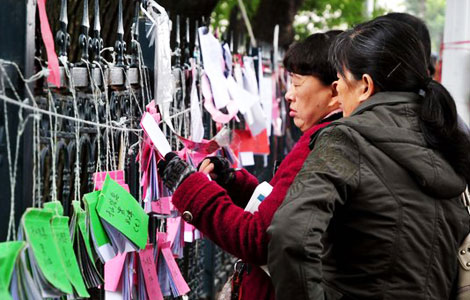Tibetan nomads settle down in new communities
Updated: 2011-12-12 17:29
(Xinhua)
|
|||||||||||
CHENGDU - Samten's family of eight gathered around the hearth in their living room Monday, chatting over yak butter tea when heavy snow blanketed their home county of Aba.
The hearth, fueled by firewood, serves as a heater and kitchen stove in their Tibetan-style house, a wooden structure with five bedrooms and enclosed by a 400-square-meter backyard.
"It's a cozy home, warm in winter and cool in summer," said Samten, a 53-year-old herder in Tsannyi township of Aba county, a Tibetan community in Southwest China's Sichuan province.
Until last year, Samten's family still kept to the traditional nomadic way of life. They had no fixed residence and migrated when the seasons changed, taking their tents, kitchen utensils and other necessities on horseback.
The tent that served as Samten's winter residence was often set up at the foot of a craggy mountain, with no roads, water or electricity.
"We had to carry water from the mountain at least 30 minutes away on foot," Samten said.
The family made about 20,000 yuan ($3,156) a year by planting highland barley and collecting herbs, he said.
"We wouldn't have been able to afford to build a decent home, even if we had wanted to," Samten said.
Samten's family was one of the first to benefit from the provincial government's resettlement program. The 18-billion-yuan program, launched in 2009, involves the construction of 1,409 new communities consisting of 100,000 homes each for all of Sichuan's Tibetan nomads.
All of the new communities will have easy access to public transportation and facilities, including schools, reading rooms, clinics, recreation centers and police stations, according to the provincial government.
By the end of last month, 1,092 of the new communities had been built and about 460,000 herdsmen had moved into new homes.
Most nomadic families can afford to own a new home, as a typical family of six people is eligible to receive 30,000 yuan in government subsidies and 30,000 yuan in zero-interest loans.
"Each family just needs to raise an additional 20,000 to 30,000 yuan," said Ding Yongxiu, an official in Tsannyi township.
The new settlers have been encouraged to stay in their new homes during the winter season. When it gets warmer in May, however, they may return to their traditional lifestyle; the government has already rationed out tents, foldaway furniture and other necessary equipment to every nomadic family for free, said Ding.
The new tents, worth 4,000 yuan each, are waterproof and provide much safer shelter for the nomads.
"Our old tent was often soaked in rain, and the biting wind penetrated it easily," said Tsering Dargye, a 40-year-old herder in Akyam township.
Tents sometimes collapse under heavy snow and rheumatism is a common disease among elderly Tibetans, he said.
Sichuan province is home to one of China's biggest Tibetan communities, alongside the Tibet autonomous region and the provinces of Qinghai, Gansu and Yunnan.
Starting in 2005, Northwest China's Qinghai province moved 50,000 Tibetan herders out of a 150,000-square-km region known as Sanjiangyuan, an area that is home to the source of the country's three major rivers: the Yangtze, Yellow and Lancang rivers.
The resettlement project was part of a 7.5-billion-yuan program sponsored by the central government to restore areas that have been damaged by excessive herding.
Today, most of the former herders live in newly built communities near town centers, with easier access to housing, medical services and vocational training.
Some of them have found manufacturing jobs at local businesses that sell traditional Tibetan handcrafts, but many miss the nomadic life of their ancestral home.
Last year, authorities in Qinghai spent an average of 900 yuan per migrant on vocational training, helping to boost the region's employment rate to 30 percent.
Sun Faping, vice president of the Qinghai Academy of Social Sciences, said that securing a job and surviving in a new environment remains the biggest challenge for the former nomads.
"It will take two or three generations to solve all the problems they are facing now," said Li.
Hot Topics
HIV/AIDS, Egypt protest, Thanksgiving, climate change, global economic recovery, home prices, high-speed railways, school bus safety, Libya situation, Weekly photos
Editor's Picks

|

|

|

|

|

|







